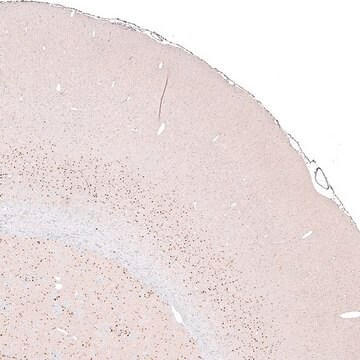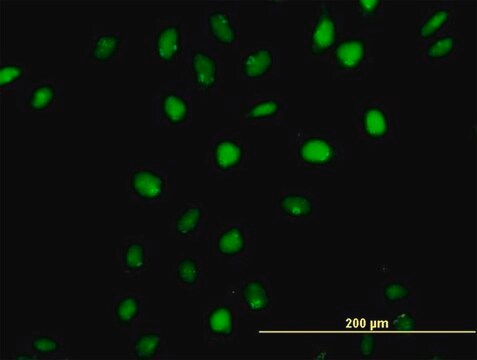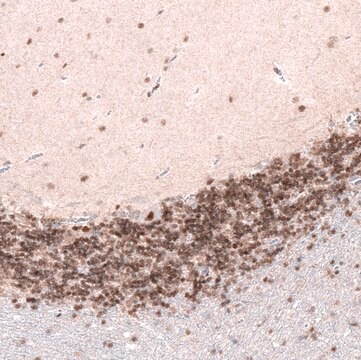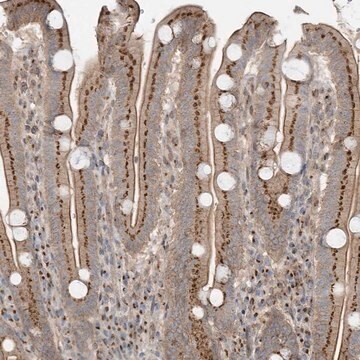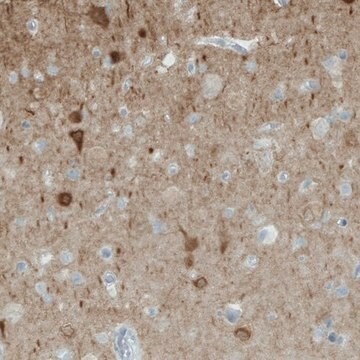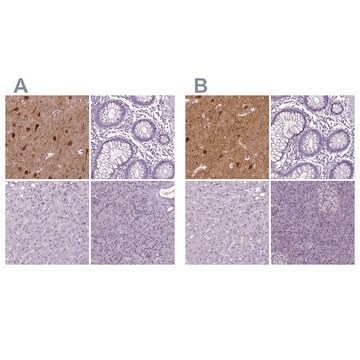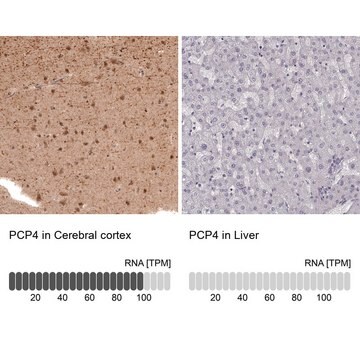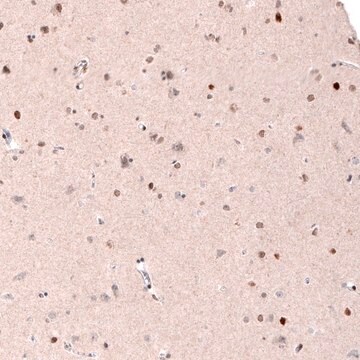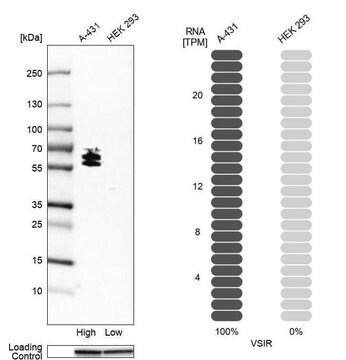HPA003277
Anti-CUX1 antibody produced in rabbit
Prestige Antibodies® Powered by Atlas Antibodies, affinity isolated antibody, buffered aqueous glycerol solution
동의어(들):
Anti-CASP, Anti-CDP, Anti-CDP/Cut, Anti-CDP/Cux, Anti-CDP1, Anti-CUT, Anti-CUTL1, Anti-CUX, Anti-Clox, Anti-Cux/CDP, Anti-GOLIM6, Anti-cut-like homeobox 1
로그인조직 및 계약 가격 보기
모든 사진(5)
About This Item
추천 제품
생물학적 소스
rabbit
결합
unconjugated
항체 형태
affinity isolated antibody
항체 생산 유형
primary antibodies
클론
polyclonal
제품 라인
Prestige Antibodies® Powered by Atlas Antibodies
양식
buffered aqueous glycerol solution
종 반응성
human
기술
immunohistochemistry: 1:20- 1:50
면역원 서열
LDPALKQAPLSQSDITILTPKLLSTSPMPTVSSYPPLAISLKKPSAAPEAGASALPNPPALKKEAQDAPGLDPQGAADCAQGVLRQVKNEVGRSGAWKDHWWS
UniProt 수납 번호
배송 상태
wet ice
저장 온도
−20°C
타겟 번역 후 변형
unmodified
유전자 정보
human ... CUX1(1523)
일반 설명
CUX1 (cut-like homeobox 1) is a transcription factor, which is localized to human chromosome 7q22.1. It is also known as CCAAT-displacement protein (CDP) or Cut-like1 (CUTL1). This protein has two isoforms, a full length called p200 CUX1 and a cathepsin L processed form called p110 CUX1. These differ in their DNA-binding capacities, and transcriptional properties.
면역원
cut-like homeobox 1 recombinant protein epitope signature tag (PrEST)
애플리케이션
All Prestige Antibodies Powered by Atlas Antibodies are developed and validated by the Human Protein Atlas (HPA) project and as a result, are supported by the most extensive characterization in the industry.
The Human Protein Atlas project can be subdivided into three efforts: Human Tissue Atlas, Cancer Atlas, and Human Cell Atlas. The antibodies that have been generated in support of the Tissue and Cancer Atlas projects have been tested by immunohistochemistry against hundreds of normal and disease tissues and through the recent efforts of the Human Cell Atlas project, many have been characterized by immunofluorescence to map the human proteome not only at the tissue level but now at the subcellular level. These images and the collection of this vast data set can be viewed on the Human Protein Atlas (HPA) site by clicking on the Image Gallery link. We also provide Prestige Antibodies® protocols and other useful information.
The Human Protein Atlas project can be subdivided into three efforts: Human Tissue Atlas, Cancer Atlas, and Human Cell Atlas. The antibodies that have been generated in support of the Tissue and Cancer Atlas projects have been tested by immunohistochemistry against hundreds of normal and disease tissues and through the recent efforts of the Human Cell Atlas project, many have been characterized by immunofluorescence to map the human proteome not only at the tissue level but now at the subcellular level. These images and the collection of this vast data set can be viewed on the Human Protein Atlas (HPA) site by clicking on the Image Gallery link. We also provide Prestige Antibodies® protocols and other useful information.
생화학적/생리학적 작용
CUX1 (cut-like homeobox 1) mediates tumor cell survival by suppressing apoptosis in pancreatic cancer. The cux genes are involved in dendrite branching, spine development, and synapse formation. This protein can control transcription in a long-range manner, and can control multiple in a certain loci. This gene is involved in tumorigenesis, and its expression in breast cancer is generally linked to less differentiated state and poor overall patient survival. In human insulinomas, it promotes pro-angiogenic invasive and malignant phenotype.
특징 및 장점
Prestige Antibodies® are highly characterized and extensively validated antibodies with the added benefit of all available characterization data for each target being accessible via the Human Protein Atlas portal linked just below the product name at the top of this page. The uniqueness and low cross-reactivity of the Prestige Antibodies® to other proteins are due to a thorough selection of antigen regions, affinity purification, and stringent selection. Prestige antigen controls are available for every corresponding Prestige Antibody and can be found in the linkage section.
Every Prestige Antibody is tested in the following ways:
Every Prestige Antibody is tested in the following ways:
- IHC tissue array of 44 normal human tissues and 20 of the most common cancer type tissues.
- Protein array of 364 human recombinant protein fragments.
결합
Corresponding Antigen APREST84786
물리적 형태
Solution in phosphate-buffered saline, pH 7.2, containing 40% glycerol and 0.02% sodium azide.
법적 정보
Prestige Antibodies is a registered trademark of Merck KGaA, Darmstadt, Germany
면책조항
Unless otherwise stated in our catalog or other company documentation accompanying the product(s), our products are intended for research use only and are not to be used for any other purpose, which includes but is not limited to, unauthorized commercial uses, in vitro diagnostic uses, ex vivo or in vivo therapeutic uses or any type of consumption or application to humans or animals.
적합한 제품을 찾을 수 없으신가요?
당사의 제품 선택기 도구.을(를) 시도해 보세요.
Storage Class Code
10 - Combustible liquids
WGK
WGK 1
Flash Point (°F)
Not applicable
Flash Point (°C)
Not applicable
가장 최신 버전 중 하나를 선택하세요:
Sebastian Krug et al.
Endocrine-related cancer, 21(6), 879-890 (2014-09-25)
Pancreatic neuroendocrine neoplasms (PNENs) constitute a rare tumour entity, and prognosis and treatment options depend on tumour-mediating hallmarks such as angiogenesis, proliferation rate and resistance to apoptosis. The molecular pathways that determine the malignant phenotype are still insufficiently understood and
Charles Vadnais et al.
BMC genomics, 14, 258-258 (2013-04-18)
Overexpression of the Cut homeobox 1 gene, CUX1, inversely correlates with patient survival in breast cancers. Cell-based assays and molecular studies have revealed that transcriptional regulation by CUX1 involves mostly the proteolytically processed p110 isoform. As there is no antibody
Beatriz Cubelos et al.
Neuron, 66(4), 523-535 (2010-06-01)
Dendrite branching and spine formation determines the function of morphologically distinct and specialized neuronal subclasses. However, little is known about the programs instructing specific branching patterns in vertebrate neurons and whether such programs influence dendritic spines and synapses. Using knockout
S Ripka et al.
Gut, 59(8), 1101-1110 (2010-05-06)
The transcription factor CUX1 is known as a regulator of cell differentiation and cell cycle progression. Previously, CUX1 was identified as a modulator of invasiveness in various cancers. Based on expression profiles suggesting a role for CUX1 in mediating chemoresistance
Bernardo Stutz et al.
Molecular psychiatry, 27(10), 3951-3960 (2022-07-30)
Hypothalamic agouti-related peptide and neuropeptide Y-expressing (AgRP) neurons have a critical role in both feeding and non-feeding behaviors of newborn, adolescent, and adult mice, suggesting their broad modulatory impact on brain functions. Here we show that constitutive impairment of AgRP
자사의 과학자팀은 생명 과학, 재료 과학, 화학 합성, 크로마토그래피, 분석 및 기타 많은 영역을 포함한 모든 과학 분야에 경험이 있습니다..
고객지원팀으로 연락바랍니다.